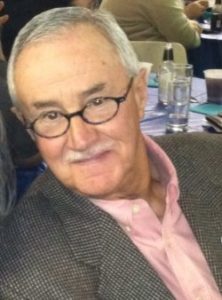by Mike Pyatt

Few may recall the1969 hit song by Peggy Lee, titled, “Is That All There Is?” It charted number 11 on U.S. Singles Pop Chart, earning her a Grammy Award. It recounts the story of one who is disillusioned with the events of life that seemed to be unique. She recounts events of watching her house catch fire, seeing a circus, falling in love for the first time. All ended with “Is that all there is?” After a recital of events she suggested, “Let’s break out the booze and have a ball-if that’s all there is.” She explained that “breathing her last breath,” she may find death disappointing as well. The song was written by the team of Jerry Leiber and Mike Stoller, responsible for most of the rock n roll standards of the 60’s. Leiber’s wife, Gabby Rosenberg, was born in Germany, and lived in the Netherlands, and escaped in advance of Nazi occupation. She introduced her song writer husband to the writings of Thomas Mann. It was a lyrical version of despair.
Most of us withstand the vicissitudes of life-that ebb and flow we all experience. Humans are resilient. We generally adapt and rebound. Nevertheless, the sudden loss of a family member or loved one rocks our world. From earliest days, we learn that life will end one day. Some adopt the romantic notion of “Living to be 80, and passing peacefully in our rocking chair.” A convenient, self-absorbing view.Then reality interrupts our reverie. Not everyone “breaks out the booze.” Some seek other forms of coping.
Take the Gintis family from North Carolina. Drew Gintis, according to his mother Marsha, “Loved wresting, it was his identity.” He began wrestling his freshman year in high school, losing most of his matches. By his junior year his record improved to 21-2. A shoulder injury ended his wrestling career his senior year. The shoulder healed. Drew didn’t. His doctor had prescribed oxycodone. At 18, Drew became addicted to painkillers. His father was a doctor.
Drew’s mother knew her son was struggling. He’d changed. Skipping classes. Inexplicable anger and mood swings. He raided their medicine cabinet. Stole pills. Drew tried heroin. In 2015, Drew entered rehab in California. He ended up in a homeless shelter. With improved stability he moved to Florida, land a job at Petco. His parents decided to drive his Civic down from North Carolina, and take his surfboard, to help him establish a return to some normalcy. Drew sent his family photos. A smile had returned to his face. His family made plans to meet him for dinner. Drew never showed.
The next morning, police phoned his mother. She asked, “Is he OK? Is he OK?” The detective was silent.Drew had died from an overdose of fentanyl on July 30, 2015. He was 21. In 2015, more Americans died of overdose than any other year on record-52,000 in that year alone. A 2015, University of Michigan study revealed, “adolescents involved in athletics are 50% more likely to use non-prescription opioids than adolescents not involved in these type of sports.” What are we to conclude? Authors of these studies were careful not point to causation. Only association. One factor is that athletes are more prone to injury. One report indicated than nearly 25% of opioid addiction begin with athletic injuries. Before his death, Drew admitted he “missed that feeling from painkillers.” What about his mother’s report that Drew’s identify was in wrestling. That’s no uncommon for adolescents.
What about adults? Historically, men find their identity in work. Job loss often leads to depression, marital strife, divorce. Even suicide. Not everyone copes with such loss. If one’s sole identity is wrapped in status, materialism, or relationships, one’s doomed to disappointment, despair, or worse. In the U.S. year after year, physicians and dentists remain the occupations with highest suicide rates, according to NIOSH. Some conclude it’s stress and competition, and occupational demands of perfection. That appears to be over simplified. Police officers rank third. More die at the hands of felons. Lawyers ranked 8th. Multiple factors are at work in these grisly statistics. Among the top five occupations for alcoholism, physicians ranked 5th. According to the Substance Abuse and Mental Health Services Administration, Miners ranked number one. Lawyers were 4th. Stress, long hours, competition, working conditions, expectations, and state of mind are mitigating contributors.
How one manages these factors may mitigate perilous outcomes. It can be traced to loss of hope. Peggy Lee suggested “break out the booze.” It’s counter intuitive to these statistics. Our culture’s driven by “Happy Hour,” which turns out to be “not so happy.” Most adult cultural, social, political, or sporting event is “fueled by alcohol.” How many adults sleep and awake with pills daily? Adolescents clumsily mimic our feeble pursuits, seeking their own “happy hour,” with equally tragic outcomes. And we’re shocked.
We’ve been warned of prolonged stays at the psychiatrist’s couch, the lure of cults, and abusing alcohol, prescription and illicit drugs. Finding solace in such pursuits is fraught with danger, and any palliative benefits are fleeting and temporal. Evangelicals understand the enticement of these transient distractions. Absent a biblical relationship with Christ, one is subject to being tossed about in this culture. Christians aren’t exempt from temptation and life’s blows. However, we’re promised an immovable anchor in these tumultuous storms. In this secular culture such archaic notions are quickly dismissed and denigrated. However, for centuries those who’ve embraced this biblical foundation, can attest to its veracity. Nevermore have we needed this message. Presidents, paupers, princes and former reprobates, slave traders, thieves, prostitutes, and worse, found enduring joy in this Good News.
Who can withstand the wiles of this barrage? Can one be inoculated from this onslaught? We’ve created a culture strangled by rampant addiction. Are we obsequiously transmitting a flawed culture to our next generation? What do you think?
Mike Pyatt’s a Natrona County resident. His email’s roderickstj@yahoo.com
